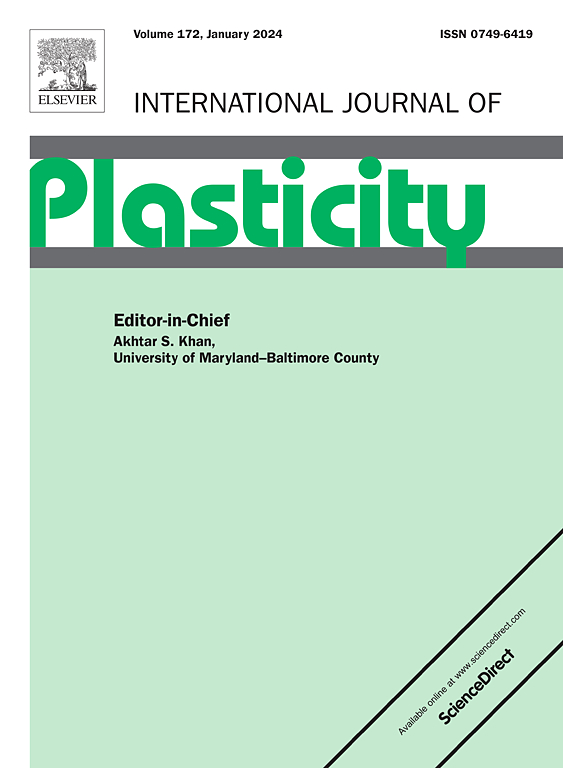The driving force for twin boundary migration in phase field model coupled to crystal plasticity finite element
IF 12.8
1区 材料科学
Q1 ENGINEERING, MECHANICAL
引用次数: 0
Abstract
Deformation twinning, a critical deformation mechanism in metal with low-symmetry crystal structures, accommodates localized shear and reorientates a domain with a specific shear and rotation angle. Twin propagation and thickening occur via twinning dislocations/disconnections at the atomic scale, while at larger scales they are governed by the migration of twin boundaries. Phase field (PF) and other continuum methods for modeling deformation twinning often incorporates self-stress effects arising from boundary defects. These self-stress fields, which are singular or discontinuous, introduce artificial forces that distort interface behavior, leading to inaccuracies in predicting interface migration and microstructure evolution. To address this issue, we propose a stress correction scheme that diminishes self-stress effects on the migration of twin interfaces. By analyzing stress field characteristics associated with three-dimensional twins with sharp or diffuse interfaces using dislocation theory and crystal plastic finite element (CPFE) method, we introduce a “correction zone” to redefine the driving force. This approach interpolates stress outside the corrected region to provide an approximate representation of the interface driving force. Validation within the CPFE framework confirms that the scheme effectively diminishes self-stress influences. Finally, we implement the correction scheme in the CPFE-PF model to simulate the dynamic evolution of a three-dimensional twin and demonstrate the twin interface migration behavior compared to the scenario that using the stress containing self-stress as driving force.


晶体塑性有限元耦合相场模型中双边界迁移的驱动力
变形孪晶是具有低对称性晶体结构的金属中的一种重要变形机制,它能够适应局部剪切,并以特定的剪切和旋转角度重新定位一个区域。在原子尺度上,孪晶的扩展和增厚是通过孪晶位错/断裂发生的,而在更大的尺度上,它们是由孪晶边界的迁移控制的。相场(PF)和其他连续体方法建模变形孪晶通常包含由边界缺陷引起的自应力效应。这些奇异或不连续的自应力场引入了人为的力,扭曲了界面行为,导致预测界面迁移和微观结构演变的不准确性。为了解决这个问题,我们提出了一种应力校正方案,以减少自应力对双界面迁移的影响。利用位错理论和晶体塑性有限元(CPFE)方法,分析了具有尖锐或扩散界面的三维孪晶的应力场特征,引入了“修正区”来重新定义驱动力。这种方法在修正区域外插入应力,以提供界面驱动力的近似表示。CPFE框架内的验证证实,该方案有效地减少了自我压力的影响。最后,我们在CPFE-PF模型中实现了修正方案,模拟了三维孪晶的动态演化,并与使用包含自应力的应力作为驱动力的情况相比,展示了孪晶界面的迁移行为。
本文章由计算机程序翻译,如有差异,请以英文原文为准。
求助全文
约1分钟内获得全文
求助全文
来源期刊

International Journal of Plasticity
工程技术-材料科学:综合
CiteScore
15.30
自引率
26.50%
发文量
256
审稿时长
46 days
期刊介绍:
International Journal of Plasticity aims to present original research encompassing all facets of plastic deformation, damage, and fracture behavior in both isotropic and anisotropic solids. This includes exploring the thermodynamics of plasticity and fracture, continuum theory, and macroscopic as well as microscopic phenomena.
Topics of interest span the plastic behavior of single crystals and polycrystalline metals, ceramics, rocks, soils, composites, nanocrystalline and microelectronics materials, shape memory alloys, ferroelectric ceramics, thin films, and polymers. Additionally, the journal covers plasticity aspects of failure and fracture mechanics. Contributions involving significant experimental, numerical, or theoretical advancements that enhance the understanding of the plastic behavior of solids are particularly valued. Papers addressing the modeling of finite nonlinear elastic deformation, bearing similarities to the modeling of plastic deformation, are also welcomed.
 求助内容:
求助内容: 应助结果提醒方式:
应助结果提醒方式:


